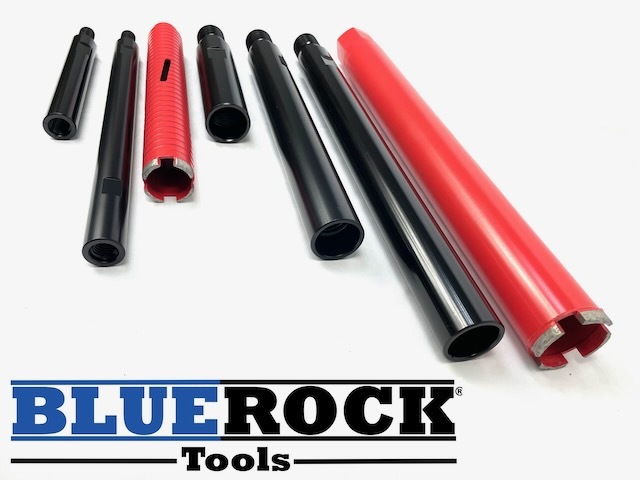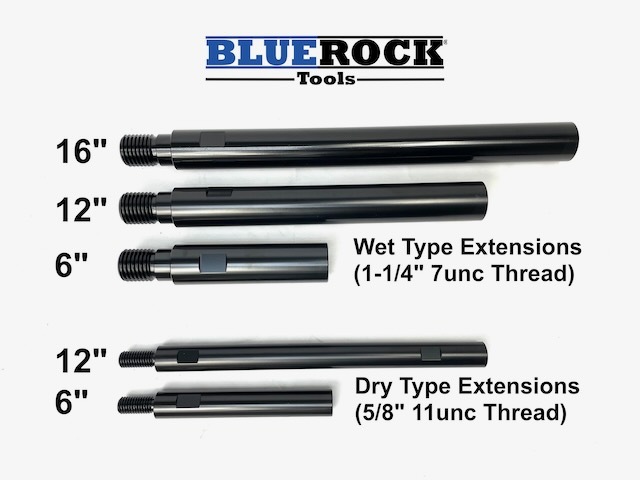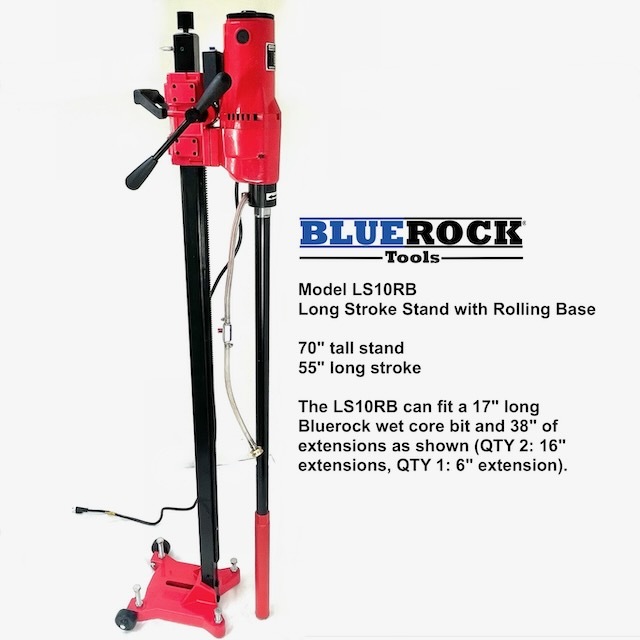Drilling Deeper with BLUEROCK® Core Drills: A Professional Guide to Using Barrel Extensions
Posted by Todd Yamashita on 4th Jun 2025
Drilling Deeper with BLUEROCK® Core Drills: A Professional Guide to Using Barrel Extensions
BLUEROCK® core drills are recognized and trusted for deep drilling in concrete, reinforced rebar, asphalt, hard rock, and masonry applications. Many of our customers use them for deep drilling—up to 14 inches or more—for applications such as decorative rock fountains, geotechnical sampling, rebar installation, utility sleeve placement, foundation retrofitting, core analysis, and groundwater relief.
One major advantage of BLUEROCK® drills is their compatibility with barrel extensions, which allow for significantly deeper drilling. This guide outlines a safe and efficient method for using these extensions.

Drilling Process
1. Set Up and Drill Initial Segment
-
Mount the drill stand securely using a wedge anchor, masonry screw, or vacuum suction base.
-
Attach the bit and connect a steady, low-pressure water supply.
-
Drill using light, even pressure until the bit reaches full depth (approximately 14").
-
Double-check the anchor point, as vibrations and drilling pressure can loosen the base.
-
Wet core drilling is strongly recommended for deeper drilling.
-
Minimum hole diameters:
-
For wet core bits with extensions: 2" minimum diameter
-
For dry bits with extensions: 1.25" minimum diameter
- Bit sizes less than the minimum sizes mentioned above will not physically fit the extensions into the hole created

-
2. Remove and Extract the Core Slug
-
Insert a chisel, wedge, or pry rod into the kerf and tap firmly until the core snaps.
-
Avoid excessive levering to prevent damage to the hole walls.
-
If the core is stubborn, drill one or two small-diameter relief holes (3/8"–1/2") parallel and close to the core edge using a rotary hammer. These help reduce internal stress and facilitate breakage.
-
Extract the core using a hook, tongs, pry bars, or lifting straps.
Alternative Extraction Method 1: Use a worn or spare core bit of the same diameter as a custom extraction sleeve. Lightly dent the barrel with a hammer, then slide it over the core—the dent acts as a grip point to lift it. For heavier cores, add deeper or multiple dents. Once extracted a rod inserted through the rear of bit can also be used to punch the core free.
Alternative Extraction Method 2: If the top of the core is visible, drill and set an eye bolt into its center. Lift it vertically using a strap or mechanical hoist.
-
For cores that are too thick or cannot be snapped, break them up using a rotary hammer with a chisel bit, or a manual cold chisel and hammer.
-
Drilling multiple vertical relief holes (~3/8") through the core weakens it for easier fragmentation.
-
Clear debris with a heavy-duty shop vacuum or manually with gloved hands.
3. Attach Extension and Continue
-
Remove the core bit and securely thread on the barrel extension.
-
Use a pipe wrench or large adjustable crescent wrench to tighten all fittings.
-
BLUEROCK® 1-1/4" extensions allow water to flow through to the bit.
-
Keep your drill stand anchored during this time and resume drilling.
-
Repeat the core extraction and extension process as needed.

⚠️ Compatibility Warning: Not all core bits and extensions from other brands are compatible. Some feature solid-core extensions that block water flow, or short threads that lead to misalignment and wobble. BLUEROCK® components are designed for seamless, stable connections.
-
For fewer interruptions, consider using a longer-stroke stand (e.g., 12Z1LRBT/S or LS10RB), which accommodates both the core bit and extension. Standard-length stands may require drilling to full bit depth before adding an extension.

Barrel extensions enable BLUEROCK® core drills to reach deeper depths with precision and consistency. Please visit bluerocktools.com for compatible accessories, tools, technical live chat support.
Category: Advanced Techniques, Concrete Rock
Disclaimer: Always follow manufacturer instructions. This guide assumes prior experience with core drilling tools. Consult with a licensed professional or structural engineer when drilling into load-bearing structures, post-tensioned concrete, or other complex environments. Users are responsible for verifying site conditions and ensuring safe, code-compliant practices. Always wear appropriate PPE: safety glasses, gloves, and hearing protection.

